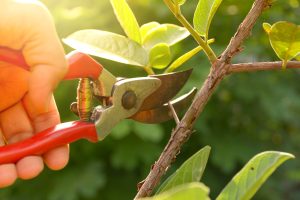
Break out the secateurs
Autumn in New Zealand gardens is often a time to start bringing out the loppers, secateurs, and shredders, and start the big prune.

A s temperatures drop, so too do the leaves of many deciduous and seasonal plants, shrubs, and trees.
Avid gardeners deadhead flowering species regularly, gaining up to three flowerings during spring and summer, into early autumn. From now on, however, is the time to deal to the last of the deadheading, and also to prune certain plants in preparation for new spring growth.
An option is to hire someone who knows what they’re doing, but for all the DIYers out there, many plants/trees are best pruned in late autumn or winter, once they are dormant.
Rule one is to know a bit about the plants in your garden, when to prune them, and how much to cut off.
Plant knowledge is essential for proper pruning, the main aim of which is to remove dead or diseased branches and stems to maintain plant health.
Rule two is to use clean (even sterilised) cutting tools. There’s no point spreading disease around the garden.
Autumn is the time to prune tender plants such as lavender and rosemary, which won’t withstand pruning in winter. The general rule with these is to prune two thirds of the growth, and leave one third.
Here are some tips about specific species:
Roses
Pruning roses can be left until later in autumn/winter, often done in New Zealand from July through to mid-August. Take off any dead or diseased wood, any spindly weak branches, and any branches that may be crossing over each other.
Opening up the centre of your plant will improve air circulation, let in more light
and prevent disease.
Make angle cuts at a 45 degree angle outward (away from the centre of the plant), and prune back to healthy green wood.
Citrus
Citrus usually only need pruning to maintain shape, or remove dead/diseased wood. In frost prone regions, such as Canterbury, avoid pruning in winter so that soft new growth isn’t killed by frost.
Hydrangeas
In warmer areas, gardeners often start pruning their hydrangeas – mopheads, lacecaps and oakleaf – in autumn, as those varieties bloom on old wood. Gardeners in cooler areas (Christchurch included) should wait until spring when all danger of frost has passed.
Hydrangeas flower on the previous year’s stems, so don’t trim them down to the ground. Snip off any straggly growth, and leave as many of the fatter buds as possible. On established bushes, cut a few of the older stems down to the ground to reduce overcrowding.
Cut, don’t kill
Clean/sterilise equipment so you don’t transfer bacteria between plants.
Prune on an angle so water doesn’t pool in the cuts
Prune on a dry day so cuts heal quickly.
Cut away all dead, dying and diseased wood.
Don’t use diseased wood for mulch or compost.



